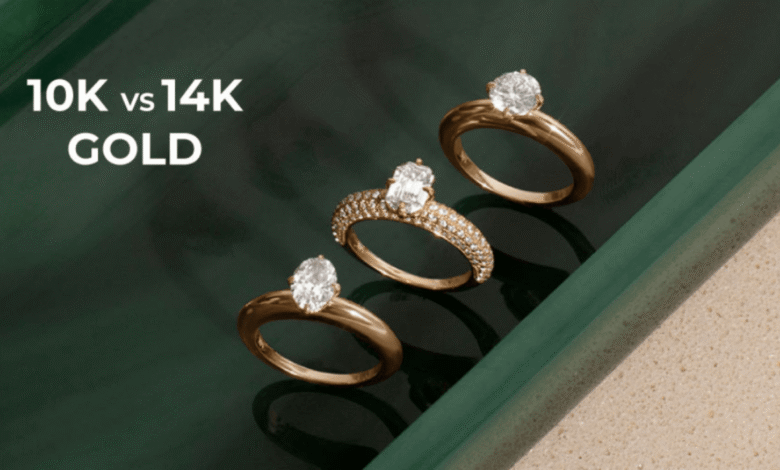My Journey with 10K vs 14K Gold

I still remember the day I decided to buy my first real gold necklace. It was my birthday, and I wanted something special—something that felt meaningful and would last. I walked into the jewelry store, eyes wide with excitement and a touch of nervousness. The display cases sparkled with rings, necklaces, and bracelets, each one more beautiful than the last. But when the salesperson asked if I preferred 10K or 14K gold, I froze. What was the difference? Why did it matter? I felt like I was back in school, about to take a test I hadn’t studied for.
That moment sparked a journey of discovery—one that taught me not just about gold but about value, commitment, and even a little about myself. As I stood there, trying to look knowledgeable, I realized I had no idea what 10K or 14K meant. The salesperson patiently explained that the “K” stands for karat, which measures the purity of gold. Pure gold is 24K, meaning it’s 100% gold. But pure gold is too soft for everyday wear, so it’s mixed with other metals to make it stronger and more durable. That’s where 10K and 14K come in.
What Even Is 10K vs 14K Gold?
- 10K Gold: This is 10 parts gold out of 24, so it’s 41.7% pure gold. The rest is made up of other metals like silver, copper, or zinc, which give it strength and durability.
- 14K Gold: This is 14 parts gold out of 24, so it’s 58.3% pure gold. It has a higher gold content than 10K, which means it has a richer, more golden color, but it’s also a bit softer.
I nodded along, but inside, I was still confused. Which one should I choose? The salesperson mentioned that 14K is more popular for fine jewelry like engagement rings, while 10K is often used for everyday pieces because it’s more affordable and durable. But I wanted something that felt special, something I could wear every day and still look beautiful.
The Differences As I See Them
After doing some research, I started to understand the differences better—not just in technical terms but in how they felt to me.
- Color and Appearance: 14K gold has a warmer, more vibrant yellow color because it has more gold in it. 10K gold, with its higher alloy content, can look a bit paler or even slightly pinkish, depending on the metals used. For me, the color was important. I wanted that classic, rich gold look, so 14K seemed more appealing. This aligns with what I learned about 10K vs 14K gold color and appearance, where 14K often stands out for its luxurious hue.
- Durability: On the other hand, 10K gold is harder and more resistant to scratches because of the higher amount of alloy metals. 14K gold, being softer, might show wear and tear more easily. But I’m not exactly hard on my jewelry—I don’t play sports or do heavy labor, so maybe durability wasn’t my top priority. This made me think about 14K gold vs 10K gold durability, and it seemed like 10K might win for toughness.
- Tarnish Resistance: Both 10K and 14K gold are pretty resistant to tarnish, but 14K, with its higher gold content, is even less likely to tarnish over time. That sounded good to me—I didn’t want my necklace to lose its shine. I wondered, does 14K gold tarnish? The answer seemed to be no, or at least not easily, compared to 10K, which might tarnish over decades with less care.
- Price and Value: And then there’s the price. 14K gold is more expensive than 10K because it has more gold in it. For someone on a budget, 10K might be the way to go. But I was willing to spend a little more for something that felt more luxurious. This led me to consider is 14K gold worth more than 10K, and yes, it is, due to the higher gold content, which also affects 10K gold price vs 14K.
Why People Choose One Over the Other
As I thought about it, I realized that people choose between 10K and 14K based on their personal needs and preferences.
- Some opt for 10K gold because it’s more affordable and durable. It’s great for everyday wear, especially if you’re active or work with your hands a lot. This made me think, which gold is better for everyday wear? It seemed like 10K, given its scratch resistance.
- Others prefer 14K gold for its richer color and higher gold content. It’s often seen as more prestigious and is the standard for fine jewelry like engagement rings and wedding bands. I noticed 10K vs 14K gold for engagement ring and 10K gold vs 14K gold for wedding band discussions often lean toward 14K for its symbolic value.
For me, it was about the emotional value. I wanted something that felt special, something that I could pass down to my children one day. 14K gold seemed to carry that weight, that sense of tradition and value, which made me wonder, which is better 10K or 14K gold for such purposes? It felt like 14K, but I wasn’t sure.
What I Chose—And Why It Mattered
When I finally made my decision, it wasn’t just about the numbers or the technical differences. It was about how each option made me feel. Holding the 10K gold necklace, it felt solid, substantial, like it could withstand anything. But when I picked up the 14K, there was something about its warmth, its deeper color that spoke to me. It felt like it had a story, like it was meant to be cherished.
I thought about my grandmother, who had a 14K gold locket that she wore every day. It was her pride and joy, passed down from her mother. I wanted something like that, something that could become a family heirloom, something that my future children could look at and say, “That was Mom’s.”
In that moment, I knew 14K was the right choice for me. It wasn’t just jewelry; it was a piece of my history, my future. I wondered, what does 10K gold mean versus 14K gold meaning? For me, 14K felt like a commitment, a promise to value myself and my story.
Durability, Value, and Meaning Over Time
Over the years, my 14K gold necklace has held up beautifully. It still shines as brightly as the day I bought it, and it hasn’t tarnished at all. I’ve worn it through countless occasions—birthdays, anniversaries, even just regular days when I wanted to feel a little extra special.
I’ve also learned that gold, like relationships, needs a bit of care. I make sure to clean it regularly and store it properly when I’m not wearing it. But beyond that, it’s been remarkably low-maintenance. I wondered, does 10K gold tarnish? It seems it can, but with care, both can last. This made me think about gold durability comparison, and both seemed strong, but 10K felt more robust for rough use.
Looking back, I wonder if I would have been just as happy with 10K gold. Probably, especially if I were on a tighter budget. But for me, the 14K gold felt right. It felt like I was investing in something that would last, both in terms of physical durability and emotional significance. This led me to ask, is 10K gold real? Yes, it is, and so is 14K, both legally solid gold in the US at 10K purity or above.
Advice I’d Give NowIf you’re trying to decide between 10K and 14K gold, here’s what I’d say:
- Consider your budget: If you’re looking for something more affordable, 10K gold is a great choice. It’s still real gold, and it’s very durable. This addresses is 10K or 14K better for budget concerns.
- Think about your lifestyle: If you’re active or work with your hands, 10K gold might be better because it’s harder and more scratch-resistant. This ties into which is better 10K or 14K gold for daily wear.
- Decide on the look you want: If you love the rich, warm color of gold, go for 14K. If you’re okay with a slightly paler shade, 10K can be just as beautiful. This covers 10K vs 14K gold appearance.
- Reflect on the meaning: Sometimes, it’s not just about the metal but what it represents to you. If you want something that feels extra special, 14K might be worth the extra cost. This touches on what’s better 10K or 14K for emotional value.
Ultimately, the choice between 10K and 14K gold is personal. It’s about what you value most—whether it’s the affordability and durability of 10K, or the richer color and higher gold content of 14K. But remember, both are beautiful, both are real gold, and both can hold immense meaning.
If you’re still unsure, maybe try them on. See how they feel on your skin, how they look in the light. Sometimes, your heart knows before your head does. And if you’re buying for someone else, think about what they would appreciate. Do they love the idea of something that’s more affordable yet still special? Or do they dream of owning a piece of fine jewelry that feels luxurious?
At the end of the day, it’s not just about the metal; it’s about the memories you’ll make with it. This reflects my journey with what’s the difference between 10K and 14K gold, and how to tell if gold is 10K or 14K—look for the stamp, and choose what feels right.
Feature Comparison
| Feature | 10K Gold | 14K Gold |
|---|---|---|
| Gold Content | 41.7% | 58.3% |
| Color | Slightly duller | Warmer, more golden |
| Durability | More scratch-resistant | Softer, but still durable |
| Tarnish Resistance | Good, may tarnish over decades | Excellent, less likely to tarnish |
| Price | More affordable | Higher price point |
| Common Usage | Everyday jewelry, casual wear | Engagement/wedding rings |
FAQs
Is 10K gold real gold?
Yes, 10K gold is real gold. It’s just mixed with other metals to make it stronger.
Is 14K gold worth the price?
It depends on what you value. If you want a richer color and higher gold content, yes. If budget is a concern, 10K might be sufficient.
Does 14K gold tarnish over time?
14K gold is very resistant to tarnish, but like any metal, it can show wear over many years.
Which gold is better for wedding rings?
14K gold is more popular for wedding rings because of its balance between durability and appearance.
Can you wear 10K gold every day?
Absolutely! 10K gold is very durable and great for everyday wear.
How do I tell if my ring is 10K or 14K?
Look for the karat stamp inside the ring. It should say “10K” or “14K.”
Is 14K gold more yellow than 10K?
Yes, 14K gold has a warmer, more yellow color because it has more pure gold.
Which lasts longer: 10K or 14K gold?
Both can last a lifetime with proper care, but 10K gold is harder and more scratch-resistant.
What’s the real difference between 10K and 14K gold?
The main differences are in purity (14K has more gold), color (14K is richer), and price (14K is more expensive). Both are durable and great for jewelry.
Our this guide reflects my journey with choosing between 10K and 14K gold, blending technical details with personal reflection to help you make your own choice. Whether you’re drawn to the durability of 10K or the richness of 14K, remember that the best choice is the one that feels right for you.





One Comment